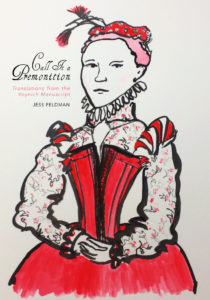What journalists the world over love to do is to bring two vaguely related things together to review or discuss, as if by doing so they identify an incipient trend or fashion. Once pointed out, of course, this trick reeks of self-indulgent modern tossery: but in the scientific interest of exploring different ways of writing about unsolved historical ciphers, I thought it might at least be a little interesting to try on this dropped shoe, to see for myself whether it’s fur or glass.
So here goes.
Jess Feldman’s “Call It a Premonition”
Jess Feldman’s slim book of poetry “Call It a Premonition” eerily subtitles itself “Translations from the Voynich Manuscript”.
When I tweeted Jess to ask how her set of poems related to the Voynich Manuscript, she replied:
I didn’t base the poems on any specific pages. Just created the poems by looking at the manuscript holistically and imagining it as the diary of a 13 year old girl. Even though it’s a different time period, I was influenced by Hilary Mantel’s Wolf Hall.
Is it any good? Well, if you want you can read the 18-page PDF here and decide for yourself (and let’s face it, it’s not going to take long). For me, though, there are some obvious highlights: and with my unsolved historical cipher hat on, I certainly couldn’t read the line in “Another Dead Fellow”…
Look:
I’ve a shiny new hairpiece. See, cuz: a mermaid
…without thinking of the curious fish/mermaid hybrid that appears on f79v in Quire 13:
Similarly, the line in “I Dreamed Of”…
a leashed hart young doe collared in soft pink bouclé
the king’s own grazing animals
…brought to my mind the strangely red-painted animal on the same page (note where the heavy painter has smooshed green paint all over the lines, so that we can’t easily discern the outlines that were originally drawn here):
Finally, “The Summer of 1438” will surely ring true for some long-suffering Cipher Mysteries readers:
I’m learning
Sometimes
Unsolved mysteries
It’s better not to ask
My favourite single poem from the set, however, is her eponymous “Call It a Premonition”, which is last but certainly not least:
In a distant future
I look like a boy only
still a girl but in slacks okay
I am moving my lacquered
fingers so text materializes
across a framed fluid tapestry
without seams Without origin
unmarried far from dead
childless and leather-booted
I say words like Co-workers,
I hate this fucking job and
I mean it but I am happy
enough I think
comparatively speaking
nonetheless
To me, this kicks an angry skateboard shoe at our foolish modernity’s ankle in a way that stings both kicker and kickee. I enjoyed it, and hope for more good Feldmany stuff in the future, slacks or otherwise. 😉
The poetry of “Supercomputer CARMEL”
In many ways, all that ackshwall poetterie couldn’t really sit further from our second contender in the ring tonight. Championed by CompSci historical cipher buff Professor Kevin Knight, CARMEL is a supercomputer running AI pattern-recognition software (according to, wait, the History Channel press release is round here somewhere) that he filled with all manner of documents and items to do with the Zodiac Killer Cipher, as part of the Hunt For The Zodiac TV documentary series that started a few days ago.
Well… that’s basically what the History Channel (and the programme makers at Karga Seven) would like us to think. However, despite all the nicely-lit close-ups of charcoal grey racks studded with the obligatory array of blinking LEDs, CARMEL isn’t a “supercomputer” at all, it’s a laboratory teaching support code toolkit developed (in C++ with a bit of Boost) and extensively tweaked over the last twenty years at the Information Sciences Institute at USC where Knight is a professor. Strictly speaking, it’s a “finite-state transducer package written by Jonathan Graehl”, that basically lets you set up a whole load of linked and/or nested finite state machines and then do all manner of clever things with them, such as train them (i.e. condition the transition weights) just by passing data into them, via either “EM (expectation-maximization) training” or “Bayesian Chinese Restaurant Process training”.
In fact, ISI students (and doubtless many others) have wheeled out the CARMEL toolkit over that period to write all manner of experimental NLP (natural language processing) software, from cipher solvers – though if you have to repeat anything “trillions of times” to get a result, something’s probably going horribly wrong with your choice of algorithm – to accelerated knowledge acquisition to (yes, you guessed it) synthetic poetry generation.
The wonderfully creepy thing is that by seeding the (CARMEL toolkit assisted) poetry generator specifically with the corpus of letters written by the Zodiac Killer, you can – with a smidgeon of justification – say that you’re generating Zodiac Killer (-seeded) poetry. It’s by no means a simulated look into his head, sure, but rather a rhyming sampling plucked from the linguistic soup apparently (on the evidence of the contents of his letters, anyway) swilling around there. Sort of.
But is this artificial poetry any good? Well, (with the caveat that I don’t know the settings or the precise keywords used to seed the particular runs) I can do no better than quote some examples given on the web and let you decide for yourself.
Existence enters your entire nation.
A twisted mind reveals becoming manic,
An endless modern ending medication,
Another rotten soul becomes dynamic.Or under pressure on genetic tests.
Surrounded by controlling my depression,
And only human torture never rests,
Or maybe you expect an easy lesson…
Handily, you can also generate your own here. I tried out a few for myself (the title of each is the keyword I chose), each took no more than a couple of seconds to pop up:
BRUTAL
Another day without a life abused.
Confused or blinded by the nitty gritty,
Afraid of being openly accused,
You and me against the world severely.
Or this:
PARADISE
Something like an angel on the vine!
An endless dream about eternal youth,
A power full of blood and sugar pine,
A sigh of love and see the naked truth.
OK, it’s not hard to see that these are simply terrible poems, mashing up pukable birthday card rhymes with a madman’s self-loathing and anger. But perhaps some entrepreneur will now use this to corner the market in psychopathic greetings cards (though perhaps even modern society has a little way further to descend before that really hits the zeitgeisty spot).
Hegelian synthesis?
This is of course the point where journalists, happy to have simulated catching a trend (or created a simulacrum of catching a trend, depending on how picky you are), press [Send], kick off their loafers, and inject some ridiculous Class A drug (or whatever journos prefer these days). “It’s a wrap!” as I once shouted angrily (having actually ordered a sandwich).
But having thought about it for a few days, I think that a common thread subtly links the two sets of poetry. In the case of Jess Feldman, she imagined herself into the inner mental world of “a 13 year old girl” living in a brutal historical period: while the Zodiac Killer text corpus also transports us (via the CompSci magic of trained finite-state transducers) into the stage of his broken psychodrama. Yet for me, the challenging link between the two is not the brutality of the two worlds (by which I mean the girl’s outer world and the Zodiac’s inner world) but the two sets’ shared performative aspect.
Why? Well: in my opinion, Jess Feldman’s poetry is – I think, but feel free to have your own opinion – written as performance pieces: the poems are not hurty / shouty / broken / combat wordplay, but stuff that could comfortably be performed: their language is consistently wry and agile, half-spoken thoughts in the grey area between what we say and what we think.
Similarly, even though the Zodiac Killer synthetic poetry is essentially an experimental linguistic simulation, it is necessarily anchored within the inherently narcissistic and manipulative language he employed for effect in his letters: and whether you like it or not, I think it is the raw language that constrains the computer’s output far more than the rhyme scheme.
Without any real doubt, the Zodiac Killer’s letters (and indeed his ciphertexts) were constructed solely for the practical needs of his hateful theatre and his need to control by terror, not for communication. The notion that we might ever actually learn something so banal as his name from any of his ciphertexts (even the Z13) seems to me ridiculous and pathetically needy: what he wrote was never a diary, but a performance that’s both as fake as Reality TV and as psychotic as Charles Manson.





Nick,
One of those witty 1930s English chaps – wish I could remember which – wrote a lovely satire on (what was then) contemporary cleverness in poetry.
As I recall, it goes:
“When I am with you
I feel happy
When you are not there,
I feel different
You are my catecheumen.
😀
thank you for the good read. I couldn’t help but google “psychopathic greetings cards”, and as you may imagine..
D: Ain’t so witty, just stupid and no wonder you can’t remember the fool’s name. Zodiac could do so much more with fewer words, but then he was black, wasn’t he?
voynichbombe: I knew the quote from Sherlock that Google suggests, but it’s not yet a particularly fashionable genre. 🙂
John,
The wit depends a fair bit on knowing how the oh-so-feeling ‘new poets’ used to recite the stuff.
but yes, probably O.T. as comment on a post about computers and psychopaths.
Well, if the author (Zodiak Killer) were about 30 yrs old at 1967, he would be quite an old person if still breathing by today (2017) . .. or is the math a little far fetched ?
Are you sure computer poetry is AI ? Most likely Kevin Knight used RKCP
( Ray Kurzweil’s Cybernetic Poet) program. Computer poetry is not new. It started in the 50’s. You might be interested in “Bot or not”
Not every look is near. No village is late.
A castle is free and every farmer is distant…Theo Lutz